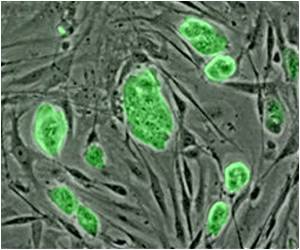A decade-long search by researchers for a gene, which is critical in controlling the formation of blood and blood vessels in the embryo, has been accomplished.

‘The cloche gene, which is critical in controlling the formation of blood and blood vessels in the embryo, has been discovered by researchers.’





This mutant lacks development of both blood vessels and blood cells, and was, until now, a unique phenomenon. Now, his research group has succeeded in finding the gene responsible for it. It had quasi hidden itself at the very end of chromosome 13 and was discovered using the latest molecular biological methods. The discovery of the gene is not only of scientific interest, but could also become important for regenerative medicine. In the mid-nineties, during his time in the United States, Didier Stainier, Director of the Department of Developmental Genetics at the Max Planck Institute for Heart and Lung Research in Bad Nauheim, discovered in the model organism zebrafish, a mutant 'possessing one of the most exciting developmental defects ever found in zebrafish', says Sven Reischauer who, together with Oliver Stone and Alethia Villasenor, is one of the main authors of the study. Due to a genetic change in this fish, none of the genes involved in the genetic program for blood and blood vessel cells were activated. Consequently, these cells cannot develop. Stainier named the mutant 'cloche' after another unique feature of the mutant, a cloche-like heart shape.
In the last two decades, various laboratories around the world took part in a real hunt for the gene behind the mutant. "Identifying Cloche was, for all of us, like solving a decades-old criminal case of genetics. However, in this case, it was not the perpetrator who was unknown but the victim, the defective gene," says Reischauer. The Max Planck researchers in Bad Nauheim, together with international partners, have now successfully finished this hunt.
"The search was made extremely complicated due to the fact that the cloche gene is located at the very end of chromosome 13, in a telomeric region", says Reischauer. Now, with methods, which have only recently become available (for example, CRISPR/Cas9 and TALEN), do we have the tools to analyse these areas. "In addition, we had to assume that the gene is only active prior to the time at which the lack of vascular growth is evident. This made it much more difficult to identify the embryos," says Reischauer.
First, the Bad Nauheim researchers examined the entire portion of the genome in which they suspected cloche to be located. Analysis of data from 26,000 genes revealed 17 genes, which could be regarded as potential candidates. Then, they deactivated all of these candidate genes separately by producing knockout lines, and examined the blood vessel growth in these embryos. "Only in one case did we find the expected picture, namely that vessel growth failed to be induced. Then we were sure that we had found the cloche gene," says Reischauer.
Advertisement
This scenario was confirmed in so-called overexpression experiments in which the researchers injected pure cloche mRNA into embryos. This approach enabled them to start the program for vascular and blood cell formation at a time during embryo development at which it is not normally active. "We could, therefore, propose we had found the gene responsible for controlling the developmental program," says Stainier.
Advertisement
Source-Eurekalert













